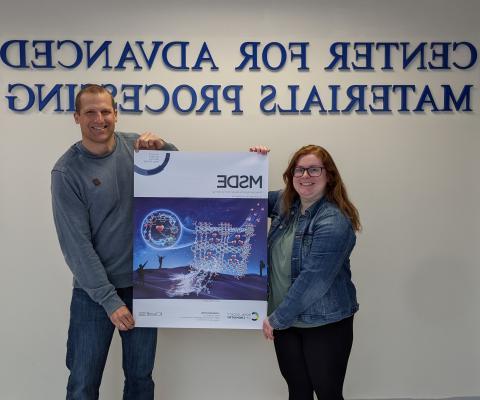Clarkson University PhD Student’s Research on Harvesting Water in Arid Climates Featured on Journal Cover of Molecular Systems Design & Engineering
The research of Clarkson University PhD student in Chemistry Charlene C. VanLeuven was recently highlighted on the front cover of one of the Royal Society of Chemistry’s flagship journals, Molecular Systems Design & Engineering, which was also featured in the journal’s Emerging Investigator Series.

Led by Kodak CAMP Distinguished Professor of Chemistry and Biomolecular Science Dr. Mario Wriedt and funded by Wriedt’s NSF CAREER award the article, titled “Water harvesting properties of a zwitterionic metal–organic framework,” outlines research VanLeuven has conducted in collaboration with Dr. Juby R. Varghese, Wriedt Lab alumna and current Research Professor in Clarkson’s Center for Air and Aquatic Resources Engineering, exploring the use of a metal–organic framework (MOF) to harvest water from low-humidity environments.
Metal-organic frameworks (MOFs) are a class of highly porous materials that are structured similarly to a jungle gym, where the nodes represent metal clusters, the struts are organic ligands, and the pores of the framework are accessible for guest molecules.
The use of this particular MOF can allow water molecules to be harvested from arid environments, like a desert, where the resource is scarce. Wriedt said the MOF is highly efficient, having been tested in conditions as low as 10 percent humidity.
Van Leuven added that this work is also a great example of how research sometimes can be made to work. It was only after the MOF was created that a way to use it for water harvesting was discovered.
“We first synthesized this MOF with different applications in mind but then we found it being very water-rich, so we were inspired by that. Omar Yaghi’s early work on similar MOFs helped us then to adapt and explore our MOF’s water harvesting potential,” she explained.
Wriedt also noted that the water can be released from the MOF using solar energy. Since humidity is higher during nighttime hours, water can be absorbed when the sun is down. Once the sun rises, its thermal energy can desorb the water for collection.
The article can be found by visiting http://bit.ly/3MX0HHP.
